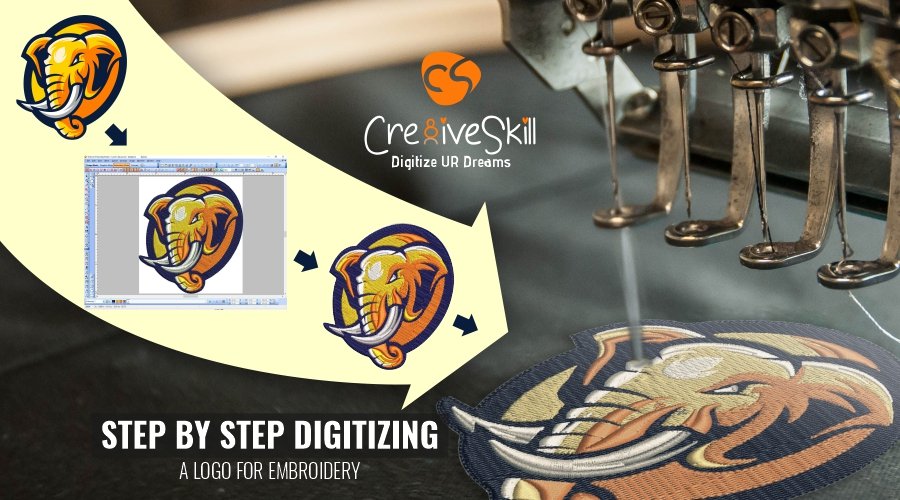Economical Digitizing for Embroidery: Accuracy and Information
Economical Digitizing for Embroidery: Accuracy and Information
Blog Article
Mastering the Needlework Digitizing Refine: Your Ultimate Overview
Needlework digitizing is a meticulous craft that requires accuracy and know-how to convert intricate styles right into digital layouts for device needlework. As craftsmens embark on this journey to master the needlework digitizing procedure, an extensive understanding of the fundamentals establishes the foundation for quality.

Recognizing Embroidery Digitizing Basics
Needlework digitizing essentials create the foundation whereupon intricate styles are equated into machine-readable styles for exact stitching. This first action in the embroidery digitizing process is crucial for guaranteeing that the last stitched item is a loyal representation of the original style. Understanding needlework digitizing basics entails comprehending essential principles such as stitch kinds, sew instructions, density, padding, and draw compensation.
Sew types play an important role in establishing the aesthetic and textural end result of the embroidered layout. By selecting the ideal stitch kind, whether it be satin, fill, or running stitch, digitizers can attain the preferred effect and boost the general high quality of the embroidery. In addition, sew direction affects the flow and measurement of the style, while thickness identifies the spacing and insurance coverage of the stitches.
Furthermore, padding stitching offers stability to the design by safeguarding the material and preventing distortion during the embroidery procedure. Pull settlement is an additional necessary factor to consider to neutralize the natural tendency of material to contract when stitched. Understanding these embroidery digitizing fundamentals is basic for creating professional-quality embroidered products.
Selecting the Right Digitizing Software Application
Choosing the appropriate digitizing software application is a crucial decision that dramatically influences the effectiveness and top quality of the embroidery digitizing procedure. Digitizing for Embroidery. When selecting the best digitizing software application, it is important to consider variables such as the complexity of layouts you prepare to create, the user-friendliness of the software, the degree of customer assistance provided, and the compatibility with your needlework maker
There are various digitizing software alternatives offered in the marketplace, ranging from fundamental programs for beginners to advanced software for specialist digitizers. Some preferred options consist of Wilcom EmbroideryStudio, Hatch Embroidery Software Program, and PulseID. These software program packages supply a large array of tools and functions to aid you produce complex styles effortlessly.
Before choosing, it is a good idea to check out the different software program alternatives with free tests or demonstrations to establish which one best matches your demands. In addition, reading testimonials and looking for referrals from knowledgeable digitizers can provide useful understandings into the strengths and weak points of each software (Digitizing for website here Embroidery). By very carefully assessing your demands and comparing the functions of various digitizing software, you can make an informed option that boosts your needlework digitizing workflow
Digitizing Devices and Techniques

Optimizing Design Setup for Embroidery
Understanding the details of layout setups is fundamental in attaining optimum outcomes in the embroidery digitizing procedure, building upon the structure laid by recognizing digitizing devices and strategies. When optimizing style setups for needlework, it is crucial to consider factors such as stitch type, density, rug, draw payment, and enrollment. Registration settings line up various aspects of the layout accurately, maintaining total design integrity.

Troubleshooting Common Digitizing Issues
When encountering typical digitizing problems during the needlework procedure, it is necessary to recognize the origin and execute reliable options quickly. One usual problem is stitch density concerns, where stitches may be as well thick, triggering the fabric to pucker, or as well sporadic, bring about spaces in the layout. Changing the stitch thickness settings in the digitizing software can aid fix this issue.
An additional frequent challenge is string breaks during the needlework procedure. This can happen due to different factors such as incorrect tension setups, boring Clicking Here needles, or utilizing low-grade thread. Ensuring correct upkeep of the embroidery maker, consisting of routine needle changes and stress modifications, can decrease the occurrence of string breaks.
In addition, design registration errors can lead to misaligned aspects within the needlework style. Examining the design positioning in the digitizing software and making essential adjustments before stitching can help in preventing this concern. By attending to these usual digitizing problems promptly and effectively, you can make sure a smoother needlework procedure and high-quality completed items.
Conclusion
To conclude, understanding the needlework digitizing procedure requires a solid understanding of the essentials, the right selection of software, and knowledge of tools and strategies. Optimizing design settings and fixing usual digitizing concerns are vital action in making certain top quality needlework results. By following these actions diligently, one can achieve precision and efficiency in the digitizing procedure.
Report this page